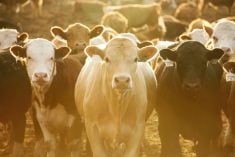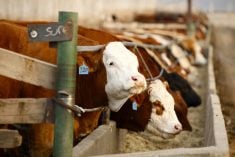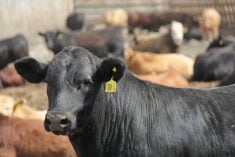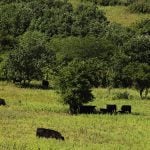Western Canadian feeder cattle prices were steady to $2 higher on average with limited sales occurring this past week. The Livestock Markets Association of Canada held its annual convention in Winnipeg on the weekend, so many sales barns were quiet.
The market at this time of year is characterized by small packages of various quality, which can make the market hard to define. However, feedlots continue to pick away because they are in the process of liquidating larger volumes of fall-placed calves over the next month. Wholesale beef prices continue to hold value near historical highs with favourable grilling weather forecast over the next week. Alberta packers bought fed cattle as high as $204 this past week, which was also a fresh all-time high. U.S. feeder prices were $2 to $5 higher on average, which spilled over into Western Canada, especially with the weaker Canadian dollar.
Read Also

U.S. grains: Soybeans, wheat plummet from highs on limited Chinese demand
Chicago soybean and wheat futures took a nosedive on Thursday, retreating from multi-month highs, as signs of only limited Chinese purchases from the United States tempered optimism about fresh demand following a bilateral trade truce.
A small group of exotic larger-frame medium-flesh heifers in the range of 760 to 800 pounds sold for an average of $245 in central Alberta. Angus-based steers averaging 775 lbs. sold for $275 in the same region. Shorter-keep cattle were well bid as slightly softer feed grain prices, along with stronger live cattle futures, allowed feedlots to lock in margins. The effects of drier conditions in parts of the Prairies have not influenced the market so far, but definitely are a factor to watch moving forward. Grassers and lighter weight categories showed more notable gains this past week, ratcheting up $5 to $8 in certain cases.
I’m expecting to see demand resurface from south of the border over the next month. Pasture conditions in the southern U.S. Plains are quite favourable with the recent rains and this could slow marketings of feeder cattle through the summer. This was confirmed on the U.S. Department of Agriculture’s recent Cattle on Feed report, with placements coming in lower than expected.
The upward momentum continues in the feeder market. Feedlots will eventually bid up the price of feeders until there is minimal margin so the market has some breathing room to move higher.
– Jerry Klassen is a commodity market analyst in Winnipeg and maintains an interest in the family feedlot in southern Alberta. He writes an in-depth biweekly commentary, Canadian Feedlot and Cattle Market Analysis, for feedlot operators in Canada. He can be reached by email at [email protected] for questions or comments.












